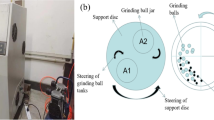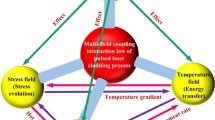Abstract
Large residual stresses in a laser-cladded surface coating over a metal part are detrimental to its mechanical integrity and fatigue life. In this study, a three-dimensional uncoupled thermo-mechanical finite element model was developed to predict (a) the evolution of the temperature field in a direct diode laser hot-wire multi-track cladding process and (b) associated thermally induced residual stress distribution in laser-cladded 316L stainless steel coatings on the A36 mild steel substrate. The thermal analysis of the finite element model of the laser cladding process was first validated by the time-resolved temperature measurements using thermocouples placed on the mild steel surface near the clad layer. The stress analysis of the finite element model during the cooling stage was then validated by the spatially-resolved X-ray diffraction measurements of residual stresses in the clad layer. The experimentally validated finite element model was then applied to investigate the effect of laser power, material properties (Young’s modulus, yield strength, and coefficient of thermal expansion), and the number of clad tracks on the residual stresses in the clad layer. It was found from the numerical simulations that the magnitude of residual stress components increases with increasing Young’s modulus, yield strength, and coefficient of thermal expansion of the clad material. A higher temperature gradient located in the molten pool induced a higher concentration of thermal stresses and eventually a higher residual stress level in the clad samples. Higher tensile residual stress was generated with an increasing number of clad tracks although the residual stress in the existing clad tracks was relaxed somewhat during the subsequent cladding process of new tracks. Specifically, high tensile transverse residual stress formed in the overlapped region and on both sides of the clad layer, whereas higher longitudinal and von Mises equivalent residual stresses were developed in the last clad track. The finite element analysis results presented in this study may provide useful guidance for reducing the residual stresses in clad layers by optimizing the multi-track laser cladding processing parameters.


















Similar content being viewed by others
Availability of data and material (data transparency)
The data supporting the conclusions are included in the article.
Code availability
The code is partially available from the corresponding author upon reasonable request.
References
Ur Rahman N, Capuano L, van der Meer A, de Rooij MB, Matthews DTA, Walmag G et al (2018) Development and characterization of multilayer laser cladded high speed steels. Addit Manuf 24:76–85. https://doi.org/10.1016/j.addma.2018.09.009
Saeedi R, ShojaRazavi R, Bakhshi SR, Erfanmanesh M, Ahmadi BA (2021) Optimization and characterization of laser cladding of NiCr and NiCr–TiC composite coatings on AISI 420 stainless steel. Ceram Int 47:4097–4110. https://doi.org/10.1016/j.ceramint.2020.09.284
Liu S, Liu W, Kovacevic R (2017) Experimental investigation of laser hot-wire cladding. Proc Inst Mech Eng Part B J Eng Manuf 231:1007–1020. https://doi.org/10.1177/0954405415578722
Jeyaprakash N, Yang C-H, Sivasankaran S (2020) Laser cladding process of cobalt and nickel based hard-micron-layers on 316L-stainless-steel-substrate. Mater Manuf Process 35:142–151. https://doi.org/10.1080/10426914.2019.1692354
El Cheikh H, Courant B, Branchu S, Hascoët J-Y, Guillén R (2012) Analysis and prediction of single laser tracks geometrical characteristics in coaxial laser cladding process. Opt Lasers Eng 50:413–422. https://doi.org/10.1016/j.optlaseng.2011.10.014
Nyoni E, Akinlabi ET (2016) Process parameter interaction effect on the evolving properties of laser metal deposited titanium for biomedical applications. Thin Solid Films 620:94–102. https://doi.org/10.1016/j.tsf.2016.09.060
Zhang Z, Kong F, Kovacevic R (2020) Laser hot-wire cladding of Co-Cr-W metal cored wire. Opt Lasers Eng 128:105998. https://doi.org/10.1016/j.optlaseng.2019.105998
Verwimp J, Rombouts M, Geerinckx E, Motmans F (2011) Applications of laser cladded WC-based wear resistant coatings. Phys Procedia 12:330–337. https://doi.org/10.1016/j.phpro.2011.03.042
Thawari N, Gullipalli C, Chandak A, Gupta TVK (2021) Influence of laser cladding parameters on distortion, thermal history and melt pool behaviour in multi-layer deposition of stellite 6: In-situ measurement. J Alloys Compd 860:157894. https://doi.org/10.1016/j.jallcom.2020.157894
Ni M, Qin X, Liu H, Hu Z (2020) Analysis and design of coaxial nozzle with rectangular outlet for high power diode laser in laser metal deposition. Int J Adv Manuf Technol 106:4789–4803. https://doi.org/10.1007/s00170-019-04874-w
Santhanakrishnan S, Kong F, Kovacevic R (2011) An experimentally based thermo-kinetic hardening model for high power direct diode laser cladding. J Mater Process Technol 211:1247–1259. https://doi.org/10.1016/j.jmatprotec.2011.02.006
Yao M, Chen X, Kong F, Tong W (2022) Process optimization of laser hot-wire cladding with high-power direct diode laser via the response surface methodology. Int J Adv Manuf Technol 120:8089–8103. https://doi.org/10.1007/s00170-022-09300-2
Liu J, Yu H, Chen C, Weng F, Dai J (2017) Research and development status of laser cladding on magnesium alloys: a review. Opt Lasers Eng 93:195–210. https://doi.org/10.1016/j.optlaseng.2017.02.007
Zhu H, Hao M, Zhang J, Ji W, Lin X, Zhang J et al (2016) Development and thermal management of 10kW CW, direct diode laser source. Opt Laser Technol 76:101–105. https://doi.org/10.1016/j.optlastec.2015.08.001
Costa Rodrigues G, Pencinovsky J, Cuypers M, Duflou JR (2014) Theoretical and experimental aspects of laser cutting with a direct diode laser. Opt Lasers Eng 61:31–38. https://doi.org/10.1016/j.optlaseng.2014.04.013
Liu S, Liu W, Harooni M, Ma J, Kovacevic R (2014) Real-time monitoring of laser hot-wire cladding of Inconel 625. Opt Laser Technol 62:124–134. https://doi.org/10.1016/j.optlastec.2014.03.007
Zhu S, Nakahara Y, Aono H, Ejima R, Yamamoto M (2021) Derivation of appropriate conditions for additive manufacturing technology using hot-wire laser method. Mater Proc 3:9. https://doi.org/10.3390/IEC2M-09244
Teichmann EW, Kelbassa J, Gasser A, Tarner S, Schleifenbaum JH (2021) Effect of wire feeder force control on laser metal deposition process using coaxial laser head. J Laser Appl 33:012041. https://doi.org/10.2351/7.0000304
Zhao S, Xu S, Huang Y, Yang L (2021) Laser hot-wire cladding of Ni/WC composite coatings with a tubular cored wire. J Mater Process Technol 298:117273. https://doi.org/10.1016/j.jmatprotec.2021.117273
Tyralla D, Seefeld T (2020) Temperature field based closed-loop control of laser hot wire cladding for low dilution. Procedia CIRP 94:451–455. https://doi.org/10.1016/j.procir.2020.09.163
Zhu S, Nakahara Y, Yamamoto M, Shinozaki K, Aono H, Ejima R (2022) Additive manufacturing phenomena of various wires using a hot-wire and diode laser. Weld World 66:1315–1327. https://doi.org/10.1007/s40194-022-01273-w
Nurminen J, Riihimäki J, Näkki J, Vuoristo P (2006) Comparison of laser cladding with powder and hot and cold wire techniques. Int Congr Appl Lasers Electro-Opt 2006:1006. https://doi.org/10.2351/1.5060747
Lu Y, Huang G, Wang Y, Li H, Qin Z, Lu X (2018) Crack-free Fe-based amorphous coating synthesized by laser cladding. Mater Lett 210:46–50. https://doi.org/10.1016/j.matlet.2017.08.125
Ding C, Cui X, Jiao J, Zhu P (2018) Effects of substrate preheating temperatures on the microstructure, properties, and residual stress of 12CrNi2 prepared by laser cladding deposition technique. Materials 11:2401. https://doi.org/10.3390/ma11122401
Bartlett JL, Li X (2019) An overview of residual stresses in metal powder bed fusion. Addit Manuf 27:131–149. https://doi.org/10.1016/j.addma.2019.02.020
MalekshahiBeiranvand Z, MalekGhaini F, NaffakhMoosavy H, Sheikhi M, Torkamany MJ, Moradi M (2020) The relation between magnesium evaporation and laser absorption and weld penetration in pulsed laser welding of aluminum alloys: experimental and numerical investigations. Opt Laser Technol 128:106170. https://doi.org/10.1016/j.optlastec.2020.106170
Moradi M, Salimi N, Ghoreishi M, Abdollahi H, Shamsborhan M, Frostevarg J et al (2014) Parameter dependencies in laser hybrid arc welding by design of experiments and by a mass balance. J Laser Appl 26:022004. https://doi.org/10.2351/1.4866675
Wang Q, Shi J, Zhang L, Tsutsumi S, Feng J, Ma N (2020) Impacts of laser cladding residual stress and material properties of functionally graded layers on titanium alloy sheet. Addit Manuf 35:101303. https://doi.org/10.1016/j.addma.2020.101303
Yao F, Fang L (2021) Thermal stress cycle simulation in laser cladding process of Ni-based coating on H13 steel. Coatings 11:203. https://doi.org/10.3390/coatings11020203
Farahmand P, Kovacevic R (2014) An experimental–numerical investigation of heat distribution and stress field in single- and multi-track laser cladding by a high-power direct diode laser. Opt Laser Technol 63:154–168. https://doi.org/10.1016/j.optlastec.2014.04.016
Zhang Z, Kovacevic R (2019) A thermo-mechanical model for simulating the temperature and stress distribution during laser cladding process. Int J Adv Manuf Technol 102:457–472. https://doi.org/10.1007/s00170-018-3127-y
Qiao X, Xia T, Chen P (2021) Numerical research on effect of overlap ratio on thermal-stress behaviors of the high-speed laser cladding coating\ast. Chin Phys B 30:018104. https://doi.org/10.1088/1674-1056/abcf9b
Hatala GW, Wang Q, Reutzel EW, Fisher CR, Semple JK (2021) A thermo-mechanical analysis of laser hot wire additive manufacturing of NAB. Metals 11:1023. https://doi.org/10.3390/met11071023
Nie Z, Wang G, McGuffin-Cawley JD, Narayanan B, Zhang S, Schwam D et al (2016) Experimental study and modeling of H13 steel deposition using laser hot-wire additive manufacturing. J Mater Process Technol 235:171–186. https://doi.org/10.1016/j.jmatprotec.2016.04.006
Bejan A, Kraus AD (2003) Heat transfer handbook. John Wiley & Sons, New York
Liu S, Farahmand P, Kovacevic R (2014) Optical monitoring of high power direct diode laser cladding. Opt Laser Technol 64:363–376. https://doi.org/10.1016/j.optlastec.2014.06.002
Pajukoski H, Näkki J, Thieme S, Tuominen J, Nowotny S, Vuoristo P (2016) High performance corrosion resistant coatings by novel coaxial cold- and hot-wire laser cladding methods. J Laser Appl 28:012011. https://doi.org/10.2351/1.4936988
Chakraborty S, Ganguly S, Talukdar P (2019) Determination of optimal taper in continuous casting billet mould using thermo-mechanical models of mould and billet. J Mater Process Technol 270:132–141. https://doi.org/10.1016/j.jmatprotec.2019.02.032
Frewin MR, Scott DA (1999) Finite element model of pulsed laser welding. Weld J-N Y 78:15-s
Kong F, Ma J, Kovacevic R (2011) Numerical and experimental study of thermally induced residual stress in the hybrid laser–GMA welding process. J Mater Process Technol 211:1102–1111. https://doi.org/10.1016/j.jmatprotec.2011.01.012
Radaj D (2012) Heat effects of welding: temperature field, residual stress, distortion. Springer Science & Business Media, Berlin
Tchoumi T, Peyraut F, Bolot R (2016) Influence of the welding speed on the distortion of thin stainless steel plates—numerical and experimental investigations in the framework of the food industry machines. J Mater Process Technol 229:216–229. https://doi.org/10.1016/j.jmatprotec.2015.07.021
Vakili-Tahami F, Zehsaz M, Saeimi-Sadigh M-A (2010) The effect of welding parameters on the burn-through during in-service welding of 316 stainless steel T joint branch connections. Recent Pat Mech Eng 3:72–81
Hemmesi K, Mallet P, Farajian M (2020) Numerical evaluation of surface welding residual stress behavior under multiaxial mechanical loading and experimental validations. Int J Mech Sci 168:105127. https://doi.org/10.1016/j.ijmecsci.2019.105127
Muthukumaran G, Babu PD (2022) Analysis of residual stress distribution and corrosion in laser surface hardened low alloy steel with a flat top-hat laser beam, using a high-power diode laser. Arab J Sci Eng. https://doi.org/10.1007/s13369-021-06350-8
Funding
This work was financially supported by the ESAB Welding & Cutting Products.
Author information
Authors and Affiliations
Contributions
Mingpu Yao: methodology, software, writing-original draft. Fanrong Kong: data curation, writing—review and editing, supervision. Wei Tong: writing-review and editing, supervision.
Corresponding authors
Ethics declarations
Ethics approval
Not applicable.
Consent to participate
Not applicable.
Consent for publication
All authors agree to give their consent to publish.
Competing interests
The authors declare no competing interests.
Additional information
Publisher's note
Springer Nature remains neutral with regard to jurisdictional claims in published maps and institutional affiliations.
Rights and permissions
Springer Nature or its licensor (e.g. a society or other partner) holds exclusive rights to this article under a publishing agreement with the author(s) or other rightsholder(s); author self-archiving of the accepted manuscript version of this article is solely governed by the terms of such publishing agreement and applicable law.
About this article
Cite this article
Yao, M., Kong, F. & Tong, W. A 3D finite element analysis of thermally induced residual stress distribution in stainless steel coatings on a mild steel by laser hot wire cladding. Int J Adv Manuf Technol 126, 759–776 (2023). https://doi.org/10.1007/s00170-023-11155-0
Received:
Accepted:
Published:
Issue Date:
DOI: https://doi.org/10.1007/s00170-023-11155-0




